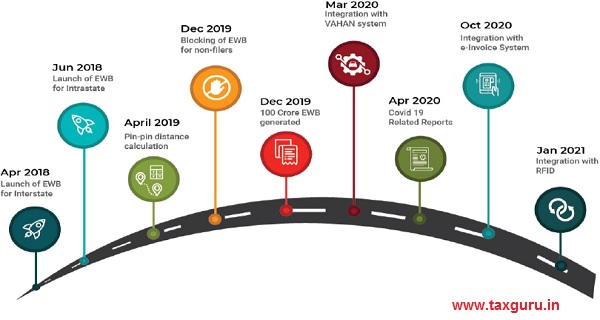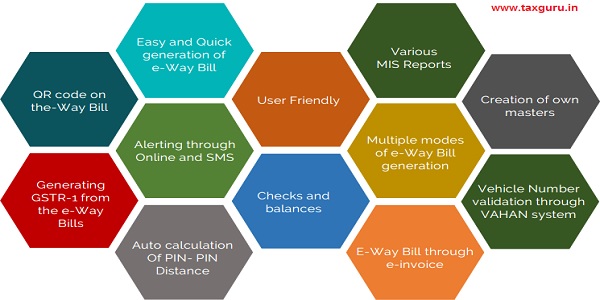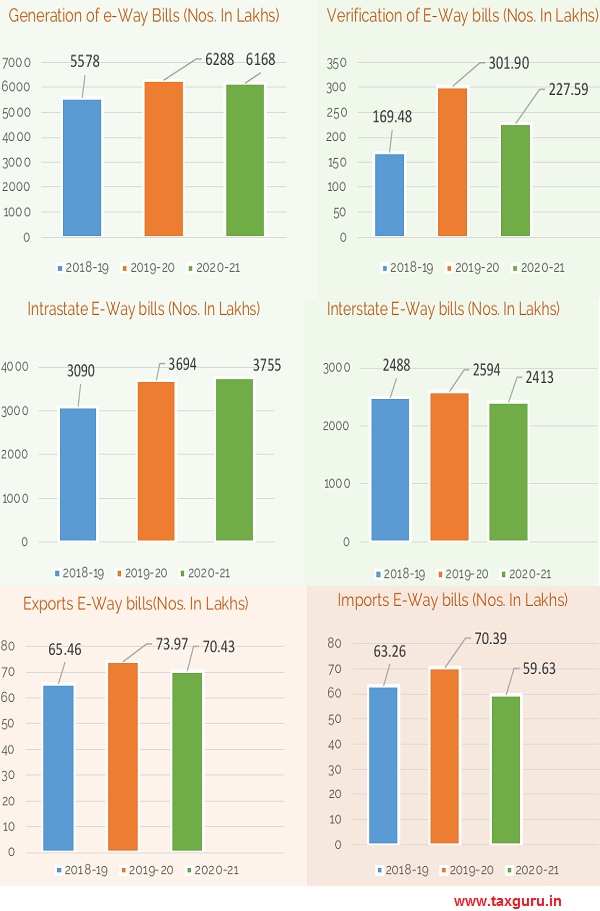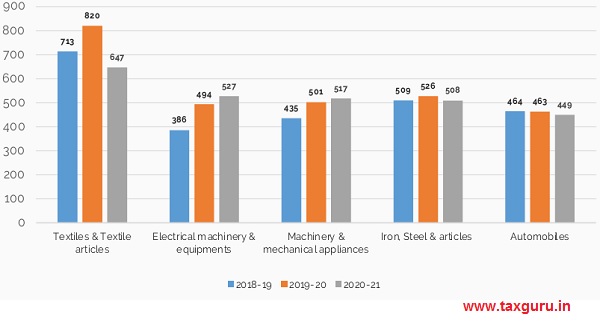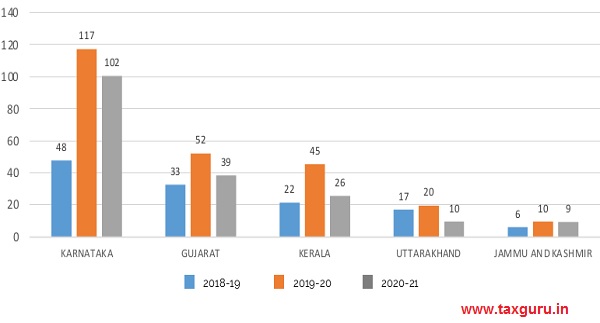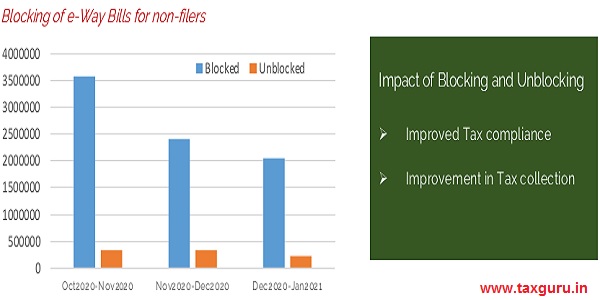Milestones
Apr 2018 – Launch of EWB for Interstate
Jun 2018 – Launch of EWB for Intrastate
April 2019 Pin-pin distance calculation
Dec 2019 Blocking of EWB for non-filers
Dec 2019 100 Crore EWB generated
Mar 2020 Integration with VAHAN system
Apr 2020 Covid 19 Related Reports
Oct 2020 Integration with e-Invoice System
Jan 2021 Integration with RFID
Salient Features
Enhancements 2019-2020
> Auto calculation of distance based on PIN Codes for generation of EWB
> Blocking the generation of multiple EWBs on one Invoice/Document
> Extension of EWB in case the consignment is in Transit/Movement
> Verification of vehicle number with VAHAN System
> Blocking/unblocking of EWB due to non-filing of Returns on GST portal
> Common enrollment-ENR 02
> Report on list of EWBs about to expire
Enhancements 2020-2021
> Updated database Pin-To-Pin distance database
> Download of E-Waybills for a month.
> Pin to Pin distances to be entered within + or – 10% of the actual distance.
> Validity period of e-waybill changed from 100 KM per day to 200 KM per day.
> Vehicle type ODC is provisioned for transport mode ‘Ship’
> e-Way Bill cannot be generated with only SAC codes(99) for Services, minimum one HSN code belonging to Goods is mandatory
> Transporters are provided with Report of e-Waybills based on assigned Date
Key Statistics from April 2018 to March 2021
| Number of E-Waybills | 180 Crores |
| Number of Vehicles | 2.2 Crores |
| Number of Users | 37.6 Lakhs |
| Number of Consignors | 35 Lakhs |
–
| Number of Consignees | 77 Lakhs |
| Number of Transporters | 0.92 Lakhs |
| Total Verifications of e-Way Bill by Officers | 7 Crores |
| Number of Officers | 0.22 Lakhs |
Year on Year Statistics
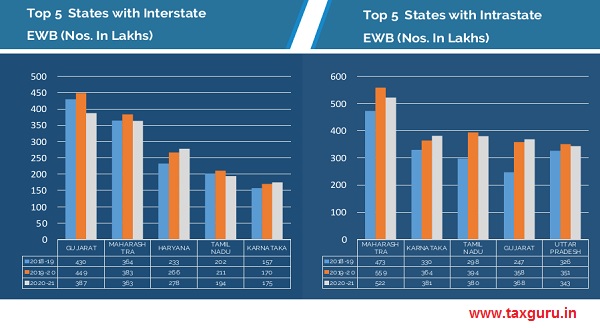 Top 5 Sectors (Nos. of E-Way Bills In Lakhs)
Top 5 Sectors (Nos. of E-Way Bills In Lakhs)
Top 5 States with Verifications (Nos. In Lakhs)
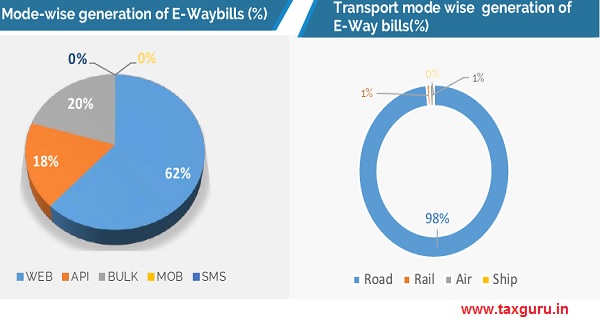
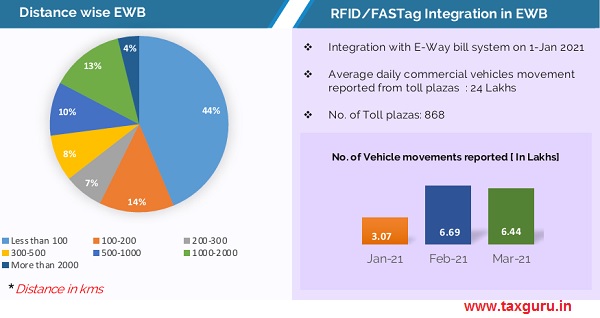 Impact of Functionalities in E-Way Bill system
Impact of Functionalities in E-Way Bill system
| Enhancement | Impact |
| Auto calculation of distance based on PIN Codes for
generation of EWB The system will auto calculate the distance between the source and destination, based on PIN codes. User can enter the actual distance limited to only 10% more than the auto calculated distance.
|
Controlled the incorrect entry of distance and thereby reduced recycling of EWBs.
|
| Blocking the generation of multiple EWBs on one Invoice/
Document If the EWB is once generated using an invoice number or document number, then none of the other parties can generate another EWB using the same invoice number.
|
Reduced generation of EWBs on the same invoice number. This has increased the tax compliance. |
Impact of Functionalities in E-Way Bill system
| ENHANCEMENTS | IMPACT |
| Auto calculation of distance based on PIN Codes for
generation of EWB The system will auto calculate the distance between the source and destination, based on PIN codes. User can enter the actual distance limited to only 10% more than the auto calculated distance.
|
Controlled the incorrect entry of distance and thereby reduced recycling of EWBs. |
| Blocking the generation of multiple EWBs on one Invoice/
Document If the EWB is once generated using an invoice number or document number, then none of the other parties can generate another EWB using the same invoice number.
|
Reduced generation of EWBs on the same invoice number. This has increased the tax compliance. |
| Extension of EWB in case the consignment is in Transit/Movement
The transporters and taxpayers may now extend the EWB both in transit or movement, by using the form of extension of validity.
|
Facilitated transporters to extend the EWBs for the consignments which have been kept in go-downs for transshipment. |
| Report on list of EWBs about to expire
Transporters and Taxpayers can now view their EWBs which are about to expire in a period of 4 days.
|
Helps in managing consignments and EWBs in a more systematic way |
| Verification of vehicle number
EWB is now integrated with Vahan system. The vehicle numbers entered in EWB system will now be verified for its existence/correctness in Vahan database. The system alerts the user on entry of incorrect vehicle numbers.
|
Reduced the entry of incorrect
vehicle numbers and thereby reduced fraudulent transactions.
|
| Blocking/unblocking of EWB due to non-filing of Returns
If the GST registered taxpayer has not filed Return 3B for the last two successive months in GST common portal, then the GSTIN is blocked for further EWB generation.
|
Improved tax compliance at
the GST Common portal.
|
| Common enrollment-ENR 02
The transporters registered in multiple states can now obtain a common enrolment number for moving the goods.
|
Helped the transporters to
update part-B details during the transshipment which happens when goods move across multiple states.
|
| Generation of E-Way Bill in e-Invoice System
E-Way Bill is now integrated with e-Invoicing system. That is with a single request , the E-Way Bill is generated by auto populating the invoice details in Part-A.
|
Simplified the process of
generating E-Way bill.
|
–
| Important reports provided to officers for identifying fraudulent taxpayers | IMPACT | |
| Helped the officers in identifying fraudulent tax payers and conducting inspections and audits. | ||
| Analytical Reports
Reports have been provided to the officers of the department depicting the probable taxpayers who are evading tax, re-cycling EWBs, bill trading or circular trading e.g. One such report is ‘EWBs Cancelled after 2 hours of generation when distance is 100 Km’. Here, the tendency of the taxpayer to cancel the EWB is studied. |
||
| Trend analysis
Patterns of taxpayers who are into fraudulent activities have been studied and analytical reports provided to identify such taxpayers. The reports on EWBs generated by newly registered taxpayers amounting to high value and deregistered soon after registration depict the probable fly by night operators who are using the EWB system. |
Helped the officers in tracking identifying the fraudulent users and take necessary action.
|
|
| Supply Chain
Circular trading is a means of claiming false Input Tax Credits by the taxpayers. By this the Government loses a large amount of revenue. The Supply chain helps to identify the chain of taxpayers who are involved in this activity. |
Helped the officers in identifying the taxpayers who have been part of this net.
|
|
| Risk Based Analysis
A set of 10-15 Key Risk Indicators (KRIs) has been identified to identify the taxpayers who may be evading the tax or claiming the tax by various means of deceitful activities. . |
Facilitate officers for further investigation.
|
|
| Analysis on Blocked / Unblocked GSTINs
Blocking of EWBs for non-filing of Returns has helped significantly in tax compliance. Reports on blocked taxpayers and their corresponding EWB transactions give a fair estimation of the tax liability. |
Helped the officers in pursuing the tax collection thereby increasing the same
|
|
| Performance Reports
Various reports to analyze the performance of officers are developed. Reports on simple verifications, detentions and tax collections by the officers are shown for the selected period. The performance is also measured by the vigilance activities done on the tax evasion prone commodities also. |
The top management finds these reports very helpful in assessing their officers and assigning the tasks.
|
|
| RFID Integration in e-Way bill system
EWB system is being integrated with RFID for monitoring the movement of goods by vehicles. Various analytical reports have been developed for dentifying the vehicles that ply with same EWBs multiple times, vehicles that are moving without EWBs etc. |
Helped in reducing the fraudulent transactions such as recycling of EWBs and bill trading.
|
|
| Action Response System
A feedback system for the officers for updating the result of the inspections conducted on taxpayers based on the MIS reports is provisioned. |
This will help all the officers in the department in creating the awareness and keeping them well informed about the behavior of the taxpayer
|
Significance of E-Way Bill during Covid-19 Lockdown
E-Waybill system was one of the vital source of information of economic activities in the country.
The system provided a number of reports for monitoring the essential commodities that moved across the nation.
The Covid-19 medical supplies report gave important insights on the type, value and the quantity of the medical items.
Reports on Covid-19 Medical Supplies
Various reports on medical supplies provided a good understanding of the movement of COVID-19 Test kits/ Protective garments , Disinfectants, Oxygen
Therapy equipment, pulse oximeters and Medical devices in the various parts of the country to the government departments
Reports on Essential Commodities
Various reports on essential commodities such as Food products, Hygiene , Fertilizers, Packaging materials has aided the governments to monitor the movements very closely.
Blocking and Unblocking of E-Waybills for non-filers of GST Returns
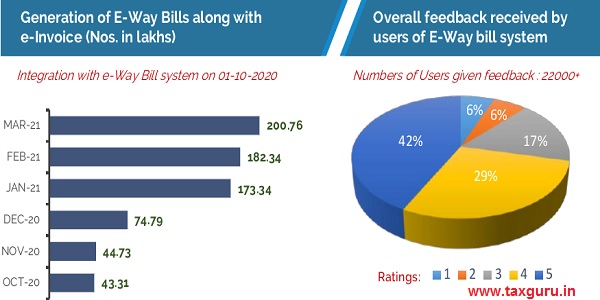
Road Ahead
| Proposed Real-time and Analysis Reports on RFID for officers | Impact |
| Real time report on Vehicle movement for selected E-Way Bill | Helps the officer in knowing the trail of movement by the vehicle |
| Real-time report on vehicles moving without e- Waybills for a selected toll plaza | Helps the officer in intercepting only those vehicles which are not having e-waybills |
| Analysis reports on identifying EWB with no movement of goods | Helps the officer in identifying cases of bill trading and circular trading |
| Analysis reports on recycling of EWB for tax evasion prone commodities | Helps the officer in identifying tax evading taxpayers |
Source- National Informatics Centre, A-Block, Lodhi Road, CGO Complex, New Delhi-110003, Website: www.nic.in, Contacts: sio-kar@nic.in


